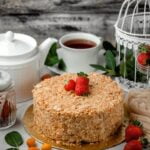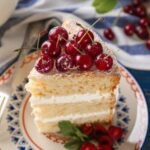Are you looking to learn how to decorate a cake? Whether you’re a baking enthusiast or just getting started, mastering the art of cake decorating can be a rewarding and creative journey.
In this article, we will cover the essential tools and materials needed for cake decorating, tips for choosing the perfect cake to decorate, basic techniques to get you started, and ways to add texture and dimension to your creations. We’ll also delve into color theory, personalizing your decorations, troubleshooting common mistakes, and encouraging beginners to keep practicing and experimenting with their skills.
Cake decorating is both a science and an art, requiring precision, creativity, and attention to detail. As beginners embark on this exciting journey, it’s important to start with the basics and gradually build confidence in their skills. This article will serve as a comprehensive guide for those who are new to cake decorating, providing step-by-step instructions and tips to help them create beautiful and delicious cakes.
Learning how to decorate a cake can be an enjoyable process that allows individuals to unleash their creativity while also honing their baking skills. Whether it’s for special occasions like birthdays, weddings, or simply as a fun hobby, mastering the art of cake decorating can bring joy and satisfaction.
With the right guidance and resources at their disposal, beginners can feel empowered to explore different techniques and experiment with various decorative elements. So let’s dive into the world of cake decorating together.
Essential Tools and Materials
When it comes to cake decorating, having the right tools and materials is essential for creating beautiful and professional-looking designs. As a beginner, it can be overwhelming to know where to start, but having a comprehensive list of essential tools and materials can make the process much easier. Some of the basic tools needed for cake decorating include piping bags, tips, spatulas, and more.
Piping bags are an indispensable tool for cake decorators, as they allow you to smoothly apply frosting and create intricate designs. There are disposable piping bags available, which are convenient for single-use projects, as well as reusable piping bags that are more durable and eco-friendly. Additionally, investing in a variety of piping tips can expand your decorating options, as different tips can create different patterns and effects with frosting.
Spatulas are another essential tool for cake decorating, particularly when it comes to applying frosting to the cake. Offset spatulas are preferred by many decorators because they provide better control and precision when spreading frosting on the cake layers.
In addition to these basic tools, other materials such as fondant, edible decorations, food coloring gels, and edible glitters can further enhance your cake decorating endeavors. With the right tools and materials at your disposal, you’ll be well-equipped to take on various cake decorating projects with confidence.
| Tools | Materials |
|---|---|
| Piping bags | Fondant |
| Piping tips | Edible decorations |
| Spatulas | Food coloring gels |
| Offset spatulas | Edible glitters |
Choosing the Perfect Cake
When it comes to cake decorating, choosing the right type of cake to work with is essential for a successful outcome. Here are some tips for selecting the perfect cake to decorate:
1. Consider the size: The size of your cake will depend on the number of servings needed and the occasion. If you’re decorating a cake for a small gathering, a single-tiered cake may suffice. For larger events, consider a tiered cake or multiple cakes.
2. Think about the shape: The shape of your cake can also play a role in its overall appearance once decorated. Round cakes are classic and versatile, while square or rectangular cakes offer a more modern look. Consider the theme or purpose of your cake when choosing its shape.
3. Choose the right flavor: The flavor of your cake should complement the overall design and theme of your decoration. Classic flavors like vanilla and chocolate are safe bets, but don’t be afraid to experiment with unique flavor combinations that reflect the personality or preferences of the person for whom you’re decorating the cake.
Remember that regardless of size, shape, or flavor, it’s important to start with a solid foundation when decorating a cake. Ensure that your chosen base has been baked and cooled properly before moving on to the next steps in the decorating process. With these considerations in mind, you’ll be well-equipped to select the perfect canvas for your cake decoration endeavors.
Basic Techniques
Decorating a cake can seem daunting, especially for beginners. However, mastering the basic techniques is key to creating beautifully decorated cakes. Below are some step-by-step guides to help you master the basics of cake decorating:
1. Frosting a Cake: Start with a crumb coat by spreading a thin layer of frosting over the entire cake to seal in any crumbs. Then, apply a thicker layer of frosting and smooth it out with an offset spatula or bench scraper for a clean finish.
2. Creating Borders: Use piping bags and various decorating tips to create borders around the edges of your cake. Practice different techniques such as shell borders, rosettes, or zig-zags to add visual interest to your cakes.
3. Smoothing Icing: Achieving smooth icing on your cake can be challenging, but with the right tools and techniques, it’s definitely achievable. Use an icing smoother or Viva paper towels to gently smooth out any imperfections on the surface of your cake.
With these basic techniques mastered, you’ll have a strong foundation for creating beautifully decorated cakes. As you practice and become more confident in your skills, you can then move on to more advanced decorating techniques such as piping intricate designs and working with fondant.
Adding Texture and Dimension
Using fondant is a popular way to add texture and dimension to a cake. Fondant is a pliable icing that can be rolled out and draped over a cake to create a smooth, seamless finish. It can also be shaped and molded to create intricate designs, such as flowers, ribbons, and other decorative elements. When using fondant, it’s important to knead it well and roll it out evenly to avoid air bubbles or cracks in the final design.
Another way to add texture and dimension to your cake is by incorporating edible decorations such as sugar flowers, piping gel designs, or edible glitter. These decorations can be used to embellish the surface of the cake, adding visual interest and creating a more dynamic overall design. When using edible decorations, consider the color scheme and theme of the cake to ensure that the decorations complement the overall look.
There are endless ways to add texture and dimension to a cake, so don’t be afraid to explore different techniques and experiment with various tools and materials. From using stencils for intricate patterns to creating edible lace with sugar or gum paste, there are plenty of options for adding interest and depth to your cake decorations.
As you gain experience with different techniques, you’ll develop a better understanding of how to use texture and dimension effectively in your cake decorating projects.
Color Theory and Combination
Understanding color theory is essential in creating visually appealing cake decorations. By learning the basics of color theory, beginners can elevate their cake decorating skills and create stunning designs. The color wheel is a fundamental tool in understanding color theory, as it illustrates the relationships between different colors. The primary colors on the color wheel are red, blue, and yellow, and they are the building blocks for creating all other colors.
Once you have a grasp of the primary colors, you can move on to exploring secondary and tertiary colors. Secondary colors are created by mixing two primary colors together, while tertiary colors are made by mixing a primary color with a secondary color.
Understanding these relationships can help you create harmonious color combinations for your cake decorations. Complementary colors are another important concept to consider – they are located directly across from each other on the color wheel and create high contrast when used together.
When applying color theory to your cake decorations, consider the mood or theme you want to convey. Warm colors like red, orange, and yellow evoke feelings of energy and warmth, while cool colors like blue, green, and purple are calming and soothing. Analogous color schemes use colors that are next to each other on the color wheel and create a sense of harmony, while complementary colors bring an element of contrast to your designs.
| Color Category | Examples |
|---|---|
| Primary Colors | Red, Blue, Yellow |
| Secondary Colors | Green (blue + yellow), Orange (red + yellow), Purple (blue + red) |
| Tertiary Colors | Vermilion (red + orange), Magenta (red + purple), Chartreuse (yellow + green) |
Customizing With Personal Touches
Customizing a cake with personal touches is a great way to make it unique and special. Whether it’s for a birthday, wedding, or other special occasion, adding monograms, edible images, or themed decorations can take your cake decorating to the next level.
Monograms
Adding a monogram to a cake is a classic way to personalize it for a special occasion. Monograms can be made out of fondant or piped onto the cake with royal icing or buttercream. They can represent the initials of the person celebrating the occasion or the couple getting married. Monograms can also be adorned with edible pearls, flowers, or other decorative elements to enhance their appearance.
Edible Images
Using edible images is another popular way to customize cakes. These images are printed on edible paper with edible ink and can be applied directly onto the surface of the cake. They can feature photographs, logos, characters, or any other image that is meaningful to the person for whom the cake is being made. Edible images are an easy and effective way to add a personal touch to a cake.
Themed Decorations
For cakes celebrating specific themes, such as sports, holidays, or hobbies, themed decorations are an ideal choice for adding personal touches. These decorations can include fondant figurines, sugar flowers, or other edible elements that reflect the theme of the event. For example, a beach-themed cake could be adorned with fondant seashells and edible sand, while a superhero-themed cake could feature fondant superhero symbols and masks.
Customizing a cake with personal touches allows beginners in cake decorating to unleash their creativity and create something truly unique and memorable. Whether it’s through monograms, edible images, or themed decorations, adding personal touches takes cake decorating to new heights and adds that extra special touch to any celebration.
Troubleshooting Tips
Cake decorating can be a fun and rewarding hobby, but like any skill, it takes practice to perfect. As a beginner, it’s common to make some mistakes along the way. However, with a few troubleshooting tips and some perseverance, you can overcome these challenges and continue to improve your cake decorating skills.
One common mistake that beginners make is not allowing their cake layers to cool completely before frosting them. This can lead to a melted or runny frosting, making it difficult to achieve a smooth finish. To fix this problem, be sure to give your cake layers plenty of time to cool before applying the frosting. You can also place your frosted cake in the refrigerator for a few minutes to help the frosting set.
Another common issue for beginners is air bubbles in their icing or frosting. These air bubbles can create an uneven and bumpy appearance on the finished cake. To prevent this from happening, try gently tapping the cake on the countertop after applying the icing to help release any trapped air bubbles. Additionally, using a small offset spatula can help smooth out any imperfections in the frosting.
Lastly, achieving the right consistency with your icing or frosting can be challenging for beginners. If your icing is too runny, add more powdered sugar to thicken it up. On the other hand, if your icing is too stiff, you can add a small amount of milk or cream to soften it. Finding the perfect consistency may take some trial and error, but with practice, you’ll get a feel for what works best for different decorating techniques.
By understanding these common beginner mistakes and learning how to troubleshoot them, you’ll be better equipped to overcome challenges in cake decorating and continue honing your skills. Remember that practice makes perfect, so don’t be discouraged by initial setbacks – keep experimenting and learning from each experience.
Conclusion
In conclusion, mastering the art of cake decorating takes time, practice, and patience. As a beginner, it’s important to start with the essential tools and materials, and then move on to choosing the perfect cake to decorate. Mastering basic techniques such as frosting a cake, creating borders, and smoothing icing will provide a solid foundation for your cake decorating skills.
Adding texture and dimension to your cakes through the use of fondant, edible decorations, and understanding color theory will elevate your creations to the next level. Don’t be afraid to add personal touches to your cake decorations, whether it’s through monograms, edible images, or themed decorations. These personal touches can make your creations stand out and truly reflect your creativity.
It’s also important to remember that making mistakes is part of the learning process. Troubleshooting tips provided in this article will help you overcome challenges and fix common beginner mistakes. Above all, keep practicing and experimenting with your cake decorating skills. With each creation, you’ll gain more experience and confidence in your abilities as a cake decorator. So don’t be discouraged by early setbacks – keep at it and enjoy the journey of becoming an accomplished cake decorator.
Frequently Asked Questions
What Does a Beginner Need for Cake Decorating?
A beginner in cake decorating will need a few essential tools and materials to get started. These include a good quality turntable, offset spatula, piping bags and tips, a bench scraper, and an assortment of food coloring gels. It’s also important to have a reliable cake recipe and buttercream frosting recipe to work with.
How to Decorate Cake in a Simple Way?
Decorating a cake in a simple way can be achieved by using basic techniques such as spreading the frosting smoothly over the cake with an offset spatula, creating simple borders with piping or frosting, and adding sprinkles or edible decorations for an extra touch.
Using pre-made fondant cutouts or molds can also add an easy decorative element to the cake.
What Is the First Step in Decorating a Cake?
The first step in decorating a cake is to ensure that the cake layers are completely cool before starting. Once the cakes are cooled, the next step is typically to level off the tops of the cakes if necessary, and then fill and stack them with frosting in between each layer.
This creates a stable base for further decorating and ensures that the layers are even. After that, a crumb coat of frosting should be applied to seal in any crumbs before proceeding with the final decoration.

Welcome to my blog about home and family. This blog is a place where I will share my thoughts, ideas, and experiences related to these important topics. I am a stay-at-home mom with two young children. I hope you enjoy reading it! and may find some helpful tips and ideas that will make your home and family life even better!





